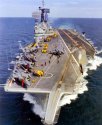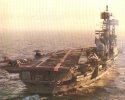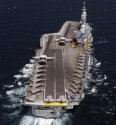Thank you too Obi Wan. I have now seen the larger/higher-res pics and have put them to good use tonight on my:I did post larger versions of these pics on the previous page...
You are using an out of date browser. It may not display this or other websites correctly.
You should upgrade or use an alternative browser.
You should upgrade or use an alternative browser.
Aircraft Carriers II (Closed to posting)
- Thread starter Jeff Head
- Start date
- Status
- Not open for further replies.
Outside the USN, I can't think of any current carrier right now were the cat does not intrude into the landing area, as all the other CVs are probably just not big enough. There's only the SaoPaulo and CdG anyway, I think.
But I would argue that the advantage of cat launch outweights the drawback of alternating launch and recovery.
But I would argue that the advantage of cat launch outweights the drawback of alternating launch and recovery.
Outside the USN, I can't think of any current carrier right now were the cat does not intrude into the landing area, as all the other CVs are probably just not big enough. There's only the SaoPaulo and CdG anyway, I think.
But I would argue that the advantage of cat launch outweights the drawback of alternating launch and recovery.
Agreed. Many commentaters seem to think that the ability to conduct simltaneous launch and recovery is of paramount importance, but most carriers in history have been incapable of this yet they operated without noticeable difficulty. Comment I have read from officers of the RN FAA who served aborad carriers indicate careful forward planning eliminates the need for simltaneous operations anyway. If the Carrier is in the middle of a launch cycle, it is very unlikely that an aircraft in need of immediate recovery is going to turn up out of the blue. Certainly there will be enough advance notice of an inbound aircraft needing to make an emergency landing that thos planes on deck awaiting launch can be put into the air and/ or re spotted out of the way, assuming the deck crew is well trained and efficient. Most Steam catapults can launch an aircraft every thirty to forty seconds, so assuming the carrier gets ten minutes notice of a returning plane having declared an emergency, the carrier (again assuming two cats, eg Sao Paolo, CdG, Ark Royal IV etc) can potentially get twenty aircraft off the deck, a significant proportion of their respective air groups. Any remaining aircraft can be re spotted to fly one leaving the angle clear for recovery. Take a look at these pictures and see how many aircraft are actually fouling the landing area during typical launch operations; these all could easily be cleared by launch or respotting in ten minutes or less.
Attachments
The USN launches and recovers simultaneously only when doing FCLPs. Fleet Carrier Landing Practice also known as Carrier qualifications i.e. CQs.
As Obi Wan stated as long as flight ops are well planned simultaneously launch and recoveries are not necessary.
As Obi Wan stated as long as flight ops are well planned simultaneously launch and recoveries are not necessary.
Another question that comes to my mind. Can the F-35B be cat launched ? Does it have the appropriate nose gear strength and configuration?
I mean if the CVFs are retrofitted with cats at some point, wich they are apparently capable of, what consequences does it have on the airwing. The RN will have STOVL SQs by then. Would GB have to purchase C variant planes for CATOBAR ops? Or can the Bs by CATOBAR launched / recovered?
In any case, they'd still be less capable then the C.
I assume the installation of cats / arrestor wires would be that expansive / complex when the infrastructure is already on the ship.(?)
I mean if the CVFs are retrofitted with cats at some point, wich they are apparently capable of, what consequences does it have on the airwing. The RN will have STOVL SQs by then. Would GB have to purchase C variant planes for CATOBAR ops? Or can the Bs by CATOBAR launched / recovered?
In any case, they'd still be less capable then the C.
I assume the installation of cats / arrestor wires would be that expansive / complex when the infrastructure is already on the ship.(?)
Another question that comes to my mind. Can the F-35B be cat launched ? Does it have the appropriate nose gear strength and configuration?
Nope. It's STVOL aircraft. But an F-35C can be cat launched.
Given that there are three different variants of the JSF operating in the US alone, you may ask what makes the F-35C unique. The C-version is the carrier based variant. It is designed to take off from a catapult system and land using an arresting hook. The United States Navy will acquire almost 500 C’s to replace the aging F/A-18 fleet. The C-variant has enlarged wing flaps to allow for more precise adjustments during a carrier approach. The wings will be able to fold up so as not to take up as much space on a cramped ship deck. Re-enforced landing gear will be used to handle the load of a high angle landing. This version will have longer and thicker wings than its sister models to provide better stability at the low speeds required during a carrier landing. The larger wing also generates a greater range which allows the fighter to reach inland targets from a carrier without the need to re-fuel. The F-35C will carrier the greatest payload of all the variants to fit the huge multi-role demand on the aircraft. Carrier based aircraft often have to be able to take on several missions in a single flight due to the limitations of carriers. Large bomber aircraft cannot launch or be recovered from the deck of a carrier, so it is left to smaller aircraft, like the F-35, to take on the deep strike missions.
Fixed it. When you click on those pics it takes you to a high res version and I had forgotten to link that last pic when I was cut and pasting html code. OK now though. Thanks!Jeff, You posted the same picture twice in your QE CVF page.
Nice page however!
...and BTW, th new CVN-78 aircraft carrier class is the USS Gerald Ford class...not the Henry Ford class. Gerald Ford was the 38th President of the United States and had a very distinguished U.S. Naval service record during World War II.
Of course I meant the Gerald Ford class. No need for the history lecture.
Ambivalent
Junior Member
Agreed. Many commentaters seem to think that the ability to conduct simltaneous launch and recovery is of paramount importance, but most carriers in history have been incapable of this yet they operated without noticeable difficulty. Comment I have read from officers of the RN FAA who served aborad carriers indicate careful forward planning eliminates the need for simltaneous operations anyway. If the Carrier is in the middle of a launch cycle, it is very unlikely that an aircraft in need of immediate recovery is going to turn up out of the blue. Certainly there will be enough advance notice of an inbound aircraft needing to make an emergency landing that thos planes on deck awaiting launch can be put into the air and/ or re spotted out of the way, assuming the deck crew is well trained and efficient. Most Steam catapults can launch an aircraft every thirty to forty seconds, so assuming the carrier gets ten minutes notice of a returning plane having declared an emergency, the carrier (again assuming two cats, eg Sao Paolo, CdG, Ark Royal IV etc) can potentially get twenty aircraft off the deck, a significant proportion of their respective air groups. Any remaining aircraft can be re spotted to fly one leaving the angle clear for recovery. Take a look at these pictures and see how many aircraft are actually fouling the landing area during typical launch operations; these all could easily be cleared by launch or respotting in ten minutes or less.
Well, the current C-13 cat requires 55 seconds between launches to build up steam pressure. In the Falklands the RN most definitely launched and recovered aircraft similtaneously. When the RN did it's studies of daily sortie rates for the CVF, STOVL was shown to allow a higher daily sortie rate than CATOBAR. The ship is designed to accept cats if the F-35B version turns out to be a dud. The RN can adopt some other aircraft in a pinch. In practice in the Falklands the RN was able to recover their Harriers in worse weather than the USN could recover their aircraft, and winds were far less critical than they are with arrested landing where the wind must be directly down the angle deck. Even a few degrees off center increases the aircraft's sink rate at the ramp dangerously. One of the stated reasons for the new flight deck configuration on the Gerald Ford class is to improve the ability to conduct similtaneous launches and recoveries.
- Status
- Not open for further replies.





